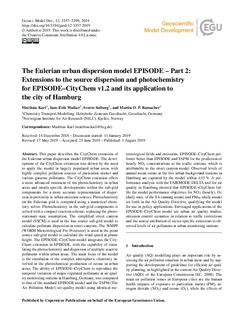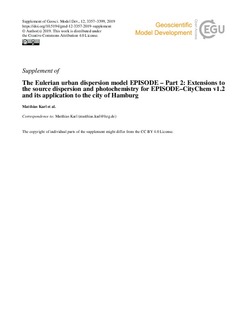| dc.contributor.author | Karl, Matthias | |
| dc.contributor.author | Walker, Sam-Erik | |
| dc.contributor.author | Solberg, Sverre | |
| dc.contributor.author | Ramacher, Martin O. P. | |
| dc.date.accessioned | 2019-08-15T12:09:05Z | |
| dc.date.available | 2019-08-15T12:09:05Z | |
| dc.date.created | 2019-08-12T13:01:14Z | |
| dc.date.issued | 2019 | |
| dc.identifier.citation | Geoscientific Model Development. 2019, 12 3357-3399. | nb_NO |
| dc.identifier.issn | 1991-959X | |
| dc.identifier.uri | http://hdl.handle.net/11250/2608519 | |
| dc.description.abstract | This paper describes the CityChem extension of the Eulerian urban dispersion model EPISODE. The development of the CityChem extension was driven by the need to apply the model in largely populated urban areas with highly complex pollution sources of particulate matter and various gaseous pollutants. The CityChem extension offers a more advanced treatment of the photochemistry in urban areas and entails specific developments within the sub-grid components for a more accurate representation of dispersion in proximity to urban emission sources. Photochemistry on the Eulerian grid is computed using a numerical chemistry solver. Photochemistry in the sub-grid components is solved with a compact reaction scheme, replacing the photo-stationary-state assumption. The simplified street canyon model (SSCM) is used in the line source sub-grid model to calculate pollutant dispersion in street canyons. The WMPP (WORM Meteorological Pre-Processor) is used in the point source sub-grid model to calculate the wind speed at plume height. The EPISODE–CityChem model integrates the CityChem extension in EPISODE, with the capability of simulating the photochemistry and dispersion of multiple reactive pollutants within urban areas. The main focus of the model is the simulation of the complex atmospheric chemistry involved in the photochemical production of ozone in urban areas. The ability of EPISODE–CityChem to reproduce the temporal variation of major regulated pollutants at air quality monitoring stations in Hamburg, Germany, was compared to that of the standard EPISODE model and the TAPM (The Air Pollution Model) air quality model using identical meteorological fields and emissions. EPISODE–CityChem performs better than EPISODE and TAPM for the prediction of hourly NO2 concentrations at the traffic stations, which is attributable to the street canyon model. Observed levels of annual mean ozone at the five urban background stations in Hamburg are captured by the model within ±15 %. A performance analysis with the FAIRMODE DELTA tool for air quality in Hamburg showed that EPISODE–CityChem fulfils the model performance objectives for NO2 (hourly), O3 (daily max. of the 8 h running mean) and PM10 (daily mean) set forth in the Air Quality Directive, qualifying the model for use in policy applications. Envisaged applications of the EPISODE–CityChem model are urban air quality studies, emission control scenarios in relation to traffic restrictions and the source attribution of sector-specific emissions to observed levels of air pollutants at urban monitoring stations. | nb_NO |
| dc.language.iso | eng | nb_NO |
| dc.rights | Navngivelse 4.0 Internasjonal | * |
| dc.rights.uri | http://creativecommons.org/licenses/by/4.0/deed.no | * |
| dc.title | The Eulerian urban dispersion model EPISODE – Part 2: Extensions to the source dispersion and photochemistry for EPISODE–CityChem v1.2 and its application to the city of Hamburg | nb_NO |
| dc.type | Journal article | nb_NO |
| dc.type | Peer reviewed | nb_NO |
| dc.description.version | publishedVersion | nb_NO |
| dc.rights.holder | © Author(s) 2019 | nb_NO |
| dc.source.pagenumber | 3357-3399 | nb_NO |
| dc.source.volume | 12 | nb_NO |
| dc.source.journal | Geoscientific Model Development | nb_NO |
| dc.identifier.doi | 10.5194/gmd-12-3357-2019 | |
| dc.identifier.cristin | 1715289 | |
| dc.relation.project | EC/H2020/689443 | nb_NO |
| cristin.unitcode | 7460,54,0,0 | |
| cristin.unitcode | 7460,57,0,0 | |
| cristin.unitname | By og industri | |
| cristin.unitname | Atmosfære og klima | |
| cristin.ispublished | true | |
| cristin.fulltext | original | |
| cristin.qualitycode | 2 | |


